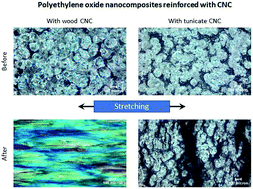How hydrogen-bonding interactions and nanocrystal aspect ratios influence the morphology and mechanical performance of polymer nanocomposites reinforced with cellulose nanocrystals†
Abstract
The performance of polymer nanocomposites reinforced with cellulose nanocrystals (CNCs) is complicated by several factors, primarily CNC–polymer and polymer–polymer interactions. Our current work specifically seeks to address the effects of CNC geometry, CNC–polymer and polymer–polymer interactions on the structure and non-linear mechanical performance of nanocomposites prepared using two water-soluble polymers, polyethylene oxide (PEO) and polyvinyl alcohol (PVA), having different morphological and structural characteristics. PEO and PVA are chosen since they are compatible with CNCs, however, they interact quite differently with CNCs and result in different reinforcement mechanisms. PEO and PVA interact with CNCs via a nucleating effect and H-bonding, which influence the polymer structure in two opposite directions. The nucleating effect tends to lead the polymer chains to form more ordered structures, whereas H-bonding interactions restrict the mobility of the polymer chains. Since PEO has weaker interactions amongst molecular chains than PVA, the properties of PEO are more significantly influenced by CNCs.



 Please wait while we load your content...
Please wait while we load your content...